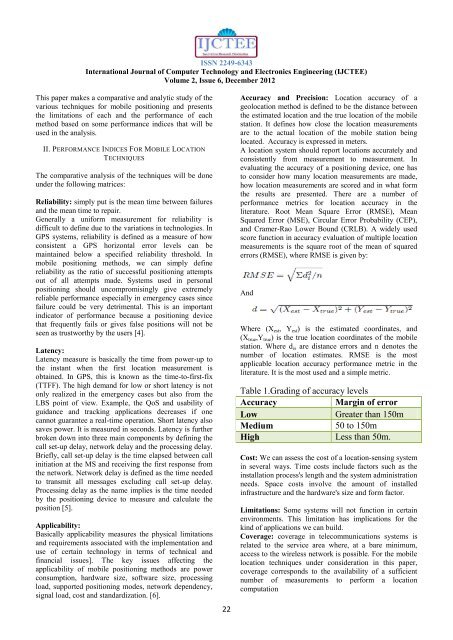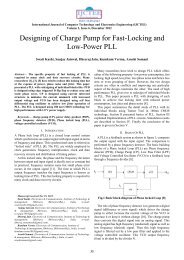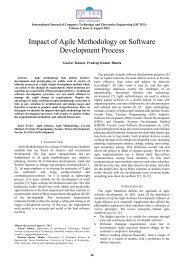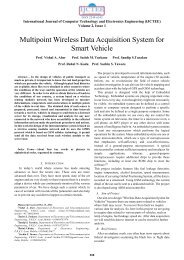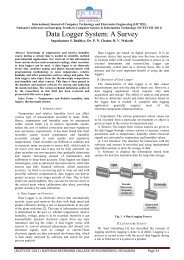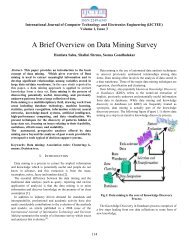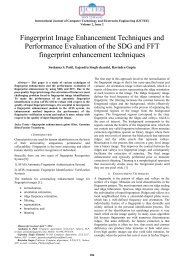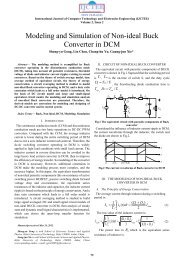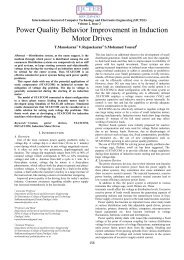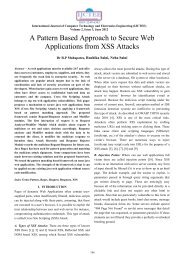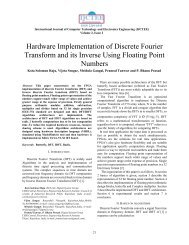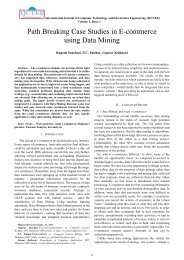Mobile Positioning Techniques in GSM Cellular Networks: A ...
Mobile Positioning Techniques in GSM Cellular Networks: A ...
Mobile Positioning Techniques in GSM Cellular Networks: A ...
You also want an ePaper? Increase the reach of your titles
YUMPU automatically turns print PDFs into web optimized ePapers that Google loves.
ISSN 2249-6343International Journal of Computer Technology and Electronics Eng<strong>in</strong>eer<strong>in</strong>g (IJCTEE)Volume 2, Issue 6, December 2012This paper makes a comparative and analytic study of thevarious techniques for mobile position<strong>in</strong>g and presentsthe limitations of each and the performance of eachmethod based on some performance <strong>in</strong>dices that will beused <strong>in</strong> the analysis.II. PERFORMANCE INDICES FOR MOBILE LOCATIONTECHNIQUESThe comparative analysis of the techniques will be doneunder the follow<strong>in</strong>g matrices:Reliability: simply put is the mean time between failuresand the mean time to repair.Generally a uniform measurement for reliability isdifficult to def<strong>in</strong>e due to the variations <strong>in</strong> technologies. InGPS systems, reliability is def<strong>in</strong>ed as a measure of howconsistent a GPS horizontal error levels can bema<strong>in</strong>ta<strong>in</strong>ed below a specified reliability threshold. Inmobile position<strong>in</strong>g methods, we can simply def<strong>in</strong>ereliability as the ratio of successful position<strong>in</strong>g attemptsout of all attempts made. Systems used <strong>in</strong> personalposition<strong>in</strong>g should uncompromis<strong>in</strong>gly give extremelyreliable performance especially <strong>in</strong> emergency cases s<strong>in</strong>cefailure could be very detrimental. This is an important<strong>in</strong>dicator of performance because a position<strong>in</strong>g devicethat frequently fails or gives false positions will not beseen as trustworthy by the users [4].Latency:Latency measure is basically the time from power-up tothe <strong>in</strong>stant when the first location measurement isobta<strong>in</strong>ed. In GPS, this is known as the time-to-first-fix(TTFF). The high demand for low or short latency is notonly realized <strong>in</strong> the emergency cases but also from theLBS po<strong>in</strong>t of view. Example, the QoS and usability ofguidance and track<strong>in</strong>g applications decreases if onecannot guarantee a real-time operation. Short latency alsosaves power. It is measured <strong>in</strong> seconds. Latency is furtherbroken down <strong>in</strong>to three ma<strong>in</strong> components by def<strong>in</strong><strong>in</strong>g thecall set-up delay, network delay and the process<strong>in</strong>g delay.Briefly, call set-up delay is the time elapsed between call<strong>in</strong>itiation at the MS and receiv<strong>in</strong>g the first response fromthe network. Network delay is def<strong>in</strong>ed as the time neededto transmit all messages exclud<strong>in</strong>g call set-up delay.Process<strong>in</strong>g delay as the name implies is the time neededby the position<strong>in</strong>g device to measure and calculate theposition [5].Applicability:Basically applicability measures the physical limitationsand requirements associated with the implementation anduse of certa<strong>in</strong> technology <strong>in</strong> terms of technical andf<strong>in</strong>ancial issues]. The key issues affect<strong>in</strong>g theapplicability of mobile position<strong>in</strong>g methods are powerconsumption, hardware size, software size, process<strong>in</strong>gload, supported position<strong>in</strong>g modes, network dependency,signal load, cost and standardization. [6].22Accuracy and Precision: Location accuracy of ageolocation method is def<strong>in</strong>ed to be the distance betweenthe estimated location and the true location of the mobilestation. It def<strong>in</strong>es how close the location measurementsare to the actual location of the mobile station be<strong>in</strong>glocated. Accuracy is expressed <strong>in</strong> meters.A location system should report locations accurately andconsistently from measurement to measurement. Inevaluat<strong>in</strong>g the accuracy of a position<strong>in</strong>g device, one hasto consider how many location measurements are made,how location measurements are scored and <strong>in</strong> what formthe results are presented. There are a number ofperformance metrics for location accuracy <strong>in</strong> theliterature. Root Mean Square Error (RMSE), MeanSquared Error (MSE), Circular Error Probability (CEP),and Cramer-Rao Lower Bound (CRLB). A widely usedscore function <strong>in</strong> accuracy evaluation of multiple locationmeasurements is the square root of the mean of squarederrors (RMSE), where RMSE is given by:AndWhere (X est , Y est ) is the estimated coord<strong>in</strong>ates, and(X true ,Y true ) is the true location coord<strong>in</strong>ates of the mobilestation. Where d is are distance errors and n denotes thenumber of location estimates. RMSE is the mostapplicable location accuracy performance metric <strong>in</strong> theliterature. It is the most used and a simple metric.Table 1.Grad<strong>in</strong>g of accuracy levelsAccuracyMarg<strong>in</strong> of errorLowGreater than 150mMedium50 to 150mHigh Less than 50m.Cost: We can assess the cost of a location-sens<strong>in</strong>g system<strong>in</strong> several ways. Time costs <strong>in</strong>clude factors such as the<strong>in</strong>stallation process's length and the system adm<strong>in</strong>istrationneeds. Space costs <strong>in</strong>volve the amount of <strong>in</strong>stalled<strong>in</strong>frastructure and the hardware's size and form factor.Limitations: Some systems will not function <strong>in</strong> certa<strong>in</strong>environments. This limitation has implications for thek<strong>in</strong>d of applications we can build.Coverage: coverage <strong>in</strong> telecommunications systems isrelated to the service area where, at a bare m<strong>in</strong>imum,access to the wireless network is possible. For the mobilelocation techniques under consideration <strong>in</strong> this paper,coverage corresponds to the availability of a sufficientnumber of measurements to perform a locationcomputation


